2 Myths and Stories of Creation
An Introduction to Creation Stories
“Imagination outstrips all the world’s magicians; it not only places the real before our eyes in a vivid images and makes distant things seem present, but also, with the power more potent than that of magic, it draws that which does not exist out of the state of potentiality, gives it a semblance of reality, an makes us see, feel, and hear these new creations.”
– Laurence des Cars, Symbolist Art (1999, p. 23)
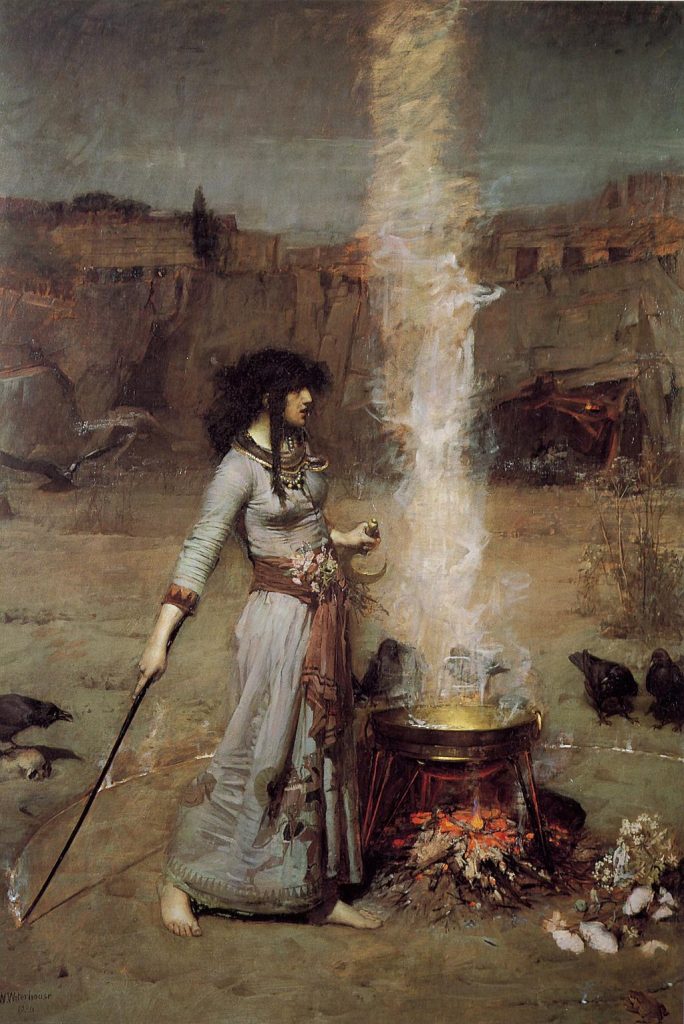
Compelling plot lines, dilemmas, and conflicts that speak to our own lives, beautiful language, and the ability of myths to transport the reader to another dimension of time and space are among the reasons educators teach myths, legends, and stories. Brown, Bradish, and Litchfield (2021) note that “he who loves the past will care sometimes to wander amid the shadow of those ancient world” (p.21). Ancient myths and legends have inspired storytellers, poets, and artists throughout time.
Integrating artistic and cross-cultural dimensions serve to enrich learners’ understandings of myths and legends. While mythic narratives are represented in unique ways by writers and artists from different historical periods, common archetypes, images, symbols, and experiences unite them. Myths provided a guide for many to human nature or an explanation of natural events such as birth, death, and the complex cycle of life. Myths speak to the nature of being human, notes Joseph Campbell (2008) in The Hero With a Thousand Faces. Conscious and unconscious fears, the power of dreams, spiritual beliefs, archetypal journeys, and life’s challenges can be understood at a deeper level by studying mythology. Universal experiences “boil up from the basic, magic ring of myth” (Campbell, 2008, p. 1). The arts, scientific discovery, religion, philosophy, and psychology are informed by ancient myths. Campbell (2008) writes that myths have flourished from time immemorial and that “they have been the living inspiration of whatever else may have appeared out of the human body and mind. It would not be too much to say that myth is a secret opening through which the inexhaustible energies of the cosmos pour into the human cultural manifestation” (p. 1). There is a connection between the microcosm of the individual and the larger macrocosm of the universe. The mythology of any culture, notes Campbell, presents a grand poetic image that is mysterious and illusive. He explains that there are four basic functions of myths:
- Myths serve to open the mind of everybody in society to that mystery dimension that cannot be analyzed, cannot be talked about but can only be experienced as out there and in here at once.
- Myths present an image of the universe that connects the transcendent of the world to the world of everyday experience. This cosmic image must reflect that mystery so that all the stars and little animals and trees and mountains are seen to express this unfathomable dimension.
- Myths present a social order by which people are coordinated to the mystery. The macrocosm of the great cosmos, the microcosm of the individual, and the order of society are all coordinated in a mysterious way.
- Myths carry the individual through the course of life. It must carry the individual from the attitudes of dependency of childhood to adult responsibility.
Nicholas Roukes (1982) explains that most classical myths are etiological and that they were invented to explain mysterious phenomenon, beliefs, customs, and behaviours. Myths serve a psychological function that can help individuals adapt to life’s challenges. Carl Jung (1947) believed that myths were a form of the collective unconscious and that archetypes, figures, and journeys in myths are expressions of universal journeys and experiences. While the personal unconscious emerges from the individual’s unique experiences in life, the “collective unconscious” is inherited from the human race thus is mutually shared by all. In essence, each person is born with a collection of thoughts, images, and knowledge that is passed down through ancestral experiences. A study of myths from a socio-psychological perspective can deepen self-awareness and empathy. Signs, symbols, ways of thinking, and patterns constitute archetypes or universal patterns of thought and behaviour. Roukes notes people maintain or even re-structure myths to suit their own needs. He writes:
In a more contemporary sense, myth making denotes one’s ability to generate any type of unique story — whether fictitious or not … the personal myth can function as an outlet for eccentric imagery, self-discovery, religious confession, or as a spiritual experience. Science fiction and illustration are yet other forms of myth making, which concern themselves with bizarre fictionalization: visitors from outer space, robots, androids, computer and machine intelligence, space travel, and galactic empires. (p. 77)
Connecting Ancient Myths to Contemporary Texts
The word myth derives from the Greek word “mythoi,” or story. These stories provided seemingly logical explanations about nature and the mysteries of birth, death, sickness, and health. As we read myths and legends from the past and as we explore the way artists depicted scenes from these poems, myths, and sagas, we get the sense that humans were trying to find meaning and answers to the complex secrets of life and in the process find the harshness of life more bearable.
Past myths and legends continue to be transformed in film, books, art, and culture in new ways; audiences in 2023 find new meaning in the fascinating plot lines and universal themes that emerge in the ways these tales are reconfigured. Myths have been re-imagined into popular texts such as Margaret Atwood’s The Penelopiad (2005) , Neil Gaiman’s Norse Myths (2017), and Madeline Miller’s Circe (2019) re-imagine ancient myths and characters in new ways that illuminate themes about love, power, revenge, courage, and strength through adversity.
R.R. Martin’s expansive fantasy novel series, A Song of Ice and Fire, is rooted in ancient myth and history. In particular, many parallels can be found between the Norse myths and the presence of frost giants, dire wolves, enchanted trees and forests, witches, and epic battles where supernatural forces intervene in different ways. The harsh climates reflect the eternal struggles of good and evil in panoramic and compelling books that include A Game of Thrones, A Clash of Kings, and A Dance with Dragons. Martin’s works have found their way into the award-winning Game of Thrones HBO series and more recently The House of Dragons series.
R.R. Tolkin’s Lord of the Rings and C.S. Lewis’s The Lion, the Witch, and the Wardrobe draw upon ancient myths and legends. We can also look for similarities across cultures in terms of myths of creation and universal symbols. The successful film Thor: Ragnarok and others attest to the popularity of myths and legends today. The writer Madeline Miller takes the mythological sorceress Circe and re-imagines her life and her relationships with Ulysses, Daedalus, Athena, and other characters. Her books The Song of Achilles (2011) and Circe (2018) have become popular bestsellers. Outcast by her divine family, Circe discovers the powers of her own magic and power. The story’s themes of love, transformation, and courage amid adversity recast ancient characters in new ways and for new audiences.
Campbell (2008) suggests the stories and themes of ancient myths are replayed throughout one’s own life and that “the latest incarnation of Oedipus, the continued romance of Beauty and the Beast, stand this afternoon on the corner of Forty-Second Street and Fifth Avenue, waiting for the traffic light to change” (p. 2). The importance of dreams, tragedy and comedy, the call to adventure, turning points, trials, transformations, the hero’s journey, and divine intervention resurface in classic myths and current narratives.
In Words from the Myths (1961), science fiction writer Isaac Asimov explains that myths were created as a moral compass and universal guide to explaining existential phenomena, personality and human nature, the cycles of nature, and the larger world. Myths are part of our culture, language, literature, philosophy, science, and history. In his compelling book, Asimov traces familiar words such as “siren,” “hypnotize,” “terrain,” “titan,” and planetary names like Saturn, Jupiter, and Mars to their ancient Greek and Roman origins. “Human beings wouldn’t be human if they didn’t wonder about the world about them … What made lightening flash? Where did the wind come from? Why would winter start soon and why would all green things die? And then why did they all come back to life the next spring?” (p. 9) The word chaos in Greek, for example, means “an open gulf” (Asimov, 1961, p. 13).
The Greeks, like many other cultures, imagined that at the beginning the universe was composed of confused and discreet matter and the “order” of the universe was created out of the chaos of outer space. The stars, planets, Earth, and animal and human life all emerged out of this chaos. Supernatural beings to be formed out of the chaos were gods. In turn, these immortal beings could control the forces of nature by directing the sunlight or making plants grow. “In the most familiar form of the Greek myths, the first beings to come out of chaos were Gaia and Ouranos. Now “gaia” is the Greek word for “earth,” and “ouranos” is the Greek word for “sky” so this is like saying that out of the original chaos, Earth and Sky were formed” (Asimov, 1961, p. 15). More recently, writers like Lise Lunge-Larsen and Gareth Hinds (2011) have created beautifully illustrated books like Gifts from the Gods: Ancient Words & Wisdom from Greek & Roman Mythology to exemplify how popular words are connected to ancient myths and legends.
Along similar lines, in Norse Mythology: Tales of the Gods, Sagas, and Heroes, Abbie Farewell Brown, Sarah Powers Bradish, and Mary Litchfield (2021) write:
We who live now have had so many things found out for us that we cannot imagine how the world seemed to people who knew very little, and who had to find out everything for themselves or make their own guesses about things. In the early ages [men] lived in a world of mystery; the sun, the moon, the sea, the wind — everything was strange and wonderful. Life was a struggle. In the north it was hard to provide for the needs of the long cold winter. Man had not learned how to control the forces of nature, and he was continually warring against them. The mountains shut him in; the forests were dark and awful; the snow and the ice and the desolate wastes set themselves against him to thwart his best endeavours. Was it strange that these hostile forces seemed like cold, heartless giants opposed to all that was joyous and gentle and human? Thus began the belief in frost giants and mountain giants.
There were also benevolent forces like the sun that enabled grass to grow and crops to ripen. And “while the sun reigned, life was happy. The sun was viewed as a god and special celebrations, poems, and songs were created to ensure that the sun would return. Odin, the king of the Nordic gods, might have been a projection of individuals’ feelings about the sun. The elements of nature were often personified as different gods and goddesses.
This chapter will highlight some of the ways that myths and legends can be linked with art to enrich learning experiences and creativity. Teaching and learning resources are provided at the end of the chapter.
Myths and Stories of Creation
A myth of creation is the symbolic narrative of the beginning of the world as understood and described by a particular culture and community. These profound and often universal truths were often communicated through oral storytelling. These stories framed a moral guide for living life in a responsible and caring way. A strong interconnection between nature and humankind existed. These insights into life served to explain the mysteries of nature, the rise and setting of the sun, planets, stars, and the seasons of nature. In creation myths, an intricate bond between individuals and nature and that in order to maintain harmony or restore balance, people would have to act in ways that showed respect and deference to a higher power (or powers). The Sandy Lake Cree First Nation people of the North America planes believed that guardian spirits protected individuals from danger. Carl Ray and James Stephens (1984) explain:
Anything can become a guardian spirit: the spirit of fire, the spirit of a legendary god; the spirit of the various animals; spirits of the wind and so on. Even dangerous things can be guardian spirits. If a person is confronted by this dangerous thing he can tell him that he has known him before in his dreams, and the dangerous thing will not harm him. IF the danger is not his guardian spirit, a man must rely on the powers of his own protector. It is the only way that he can save himself.” (Carl Ray and James Stevens, Sacred Legends of the Sandy Lake Cree).
Animal, plant, and human life were interconnected and specific animals symbolized different traits. For example, the turtle represented fertility and longevity, stability, and the connection to the earth. The Cree, Ojibwa, and Iroquois people connected the turtle to Mother Earth. North America is referred to as “turtle island”; the hard shell of the turtle symbolized the earth. The buffalo symbolized gentleness, stability, freedom, and abundance. Different animals had different symbolic meanings to our ancestors.
Further Information:
https://www.thecanadianencyclopedia.ca/en/article/religion-of-aboriginal-people
World Mythology:
For additional information about myths from around the world please open the web site Mythopedia (the encyclopedia of mythology). “Discover the myths, legends, and cosmology of ancient cultures”
Sedna: Mother of the Seas
At the core of the Inuit systems of belief was the myth of Sedna (Sea Woman) , the sea goddess and mother to all sea animals. As Wilkinson (2019) explains, the northernmost region of North America is home to many extraordinary tales and myths that feature stories of the sea and its deities. Inuit life was dependent on the sea and the availability of fish, seals, walruses, and whales. Mystical shaman were said to be able to communicate with these spirits. “Inua” or spirit helpers often took animal forms. Sedna could calm the sea or whip up storms; she was said to influence the migration of birds and animals. “In the Inuit mythological framework, Sedna personified both the tragedies of life and the mysteries of creation. Her great power came from her control of the sea animals on which people depended on for their survival.” (p.7). Sedna began her life as a young girl but after a serious of tragic events, she undergoes a supernatural transformation to be the mother of the sea animals.
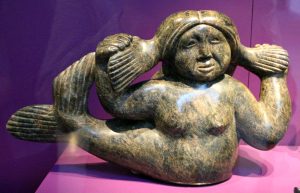
Haida Myth of Creation
To the Indigenous people of the Northwest coast, the raven was a powerful guardian spirit. Often viewed as the Trickster god who possessed both positive and negative features (intelligence by mischievious). The Raven is viewed by many Indigenous cultures in North America as the creator god or the god of light. The cycles of nature and explanations for how daylight began or why summer and winter alternative are found in many raven tales. As a trickster figure, the raven is also a catalyst of mischief and mayhem. The raven is associated with qualities such as intelligence, curiosity, craftiness, and strength. In the Bill Reid cedarwood carving, the raven is depicted opening an oyster shell on “Haida Gwaii”(Queen Charlotte Islands). The clam opens and the first humans emerge. The sculptor Bill Reid is internationally renowned and his sculptures, paintings, and jewellery can be found in art galleries and museums around the world. It was only as a teenager that Reid discovered his Haida roots. Fascinated by his rich cultural history, Reid began to create artifacts that illuminated different legends and stories of the Haida First Nation. This ancestral knowledge inspired his life and work.
The Raven and the First Men
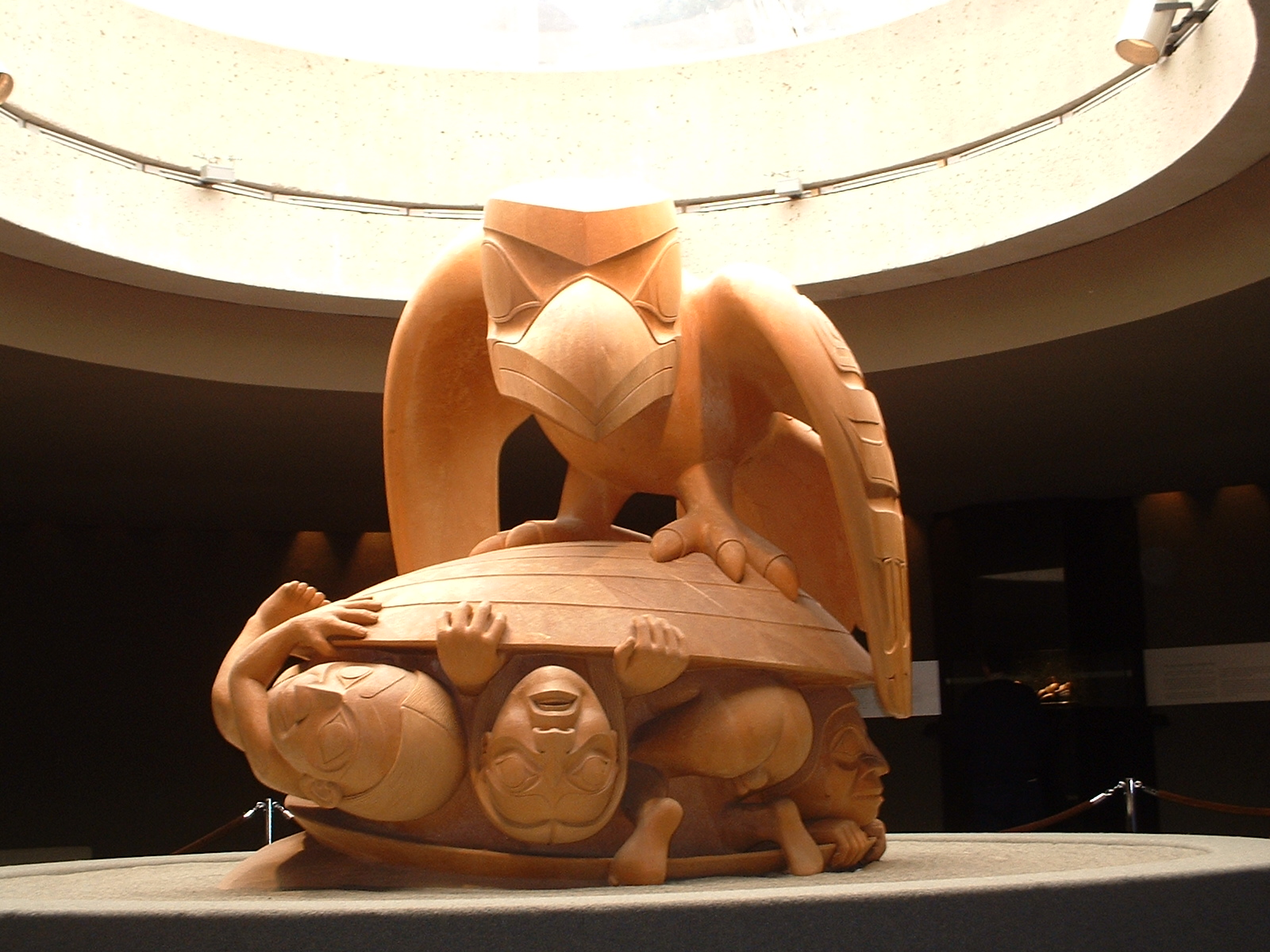
—
“According to Haida legend, the Raven found himself alone one day on Rose Spit beach, on Haida
Gwaii. Suddenly, he saw an extraordinary clamshell at his feet, and protruding from it were a number
of small creatures. The Raven coaxed them to leave the shell to join him in his wonderful world.
Some were hesitant at first, but eventually, overcome by curiosity, they emerged from the partly open
clamshell to become the first Haida. “-Anne Cross, 1990 and updated by Karen Duffek, 2011, Museum of Cultural Anthropology, Vancouver, British Columbia).
—
For more information about Bill Reid and his art work please go to:
https://moa.ubc.ca/2020/01/the-raven-and-the-first-men-from-conception-to-completion/
The Raven and the First Men: From Conception to Completion – Museum of Anthropology at UBC
The Canadian Encyclopedia
https://www.thecanadianencyclopedia.ca/en/article/william-ronald-reid
Resources for Creation Myths
Campbell, J. (2008). The hero with a thousand faces. New World Library.
https://www.britannica.com/topic/creation-myth
https://www.cs.williams.edu/~lindsey/myths/myths.html
Walking Together: Creation Stories as Spiritual Foundation (First Nations, Metis, and Inuit Perspectives in Curriculum) https://www.learnalberta.ca/content/aswt/oral_tradition/documents/creation_stories_as_spiritual_foundation.pdf
Gilbert White (1877-1939) , The Raven, 1879, The Natural History of Selborne, Calendar
Image.
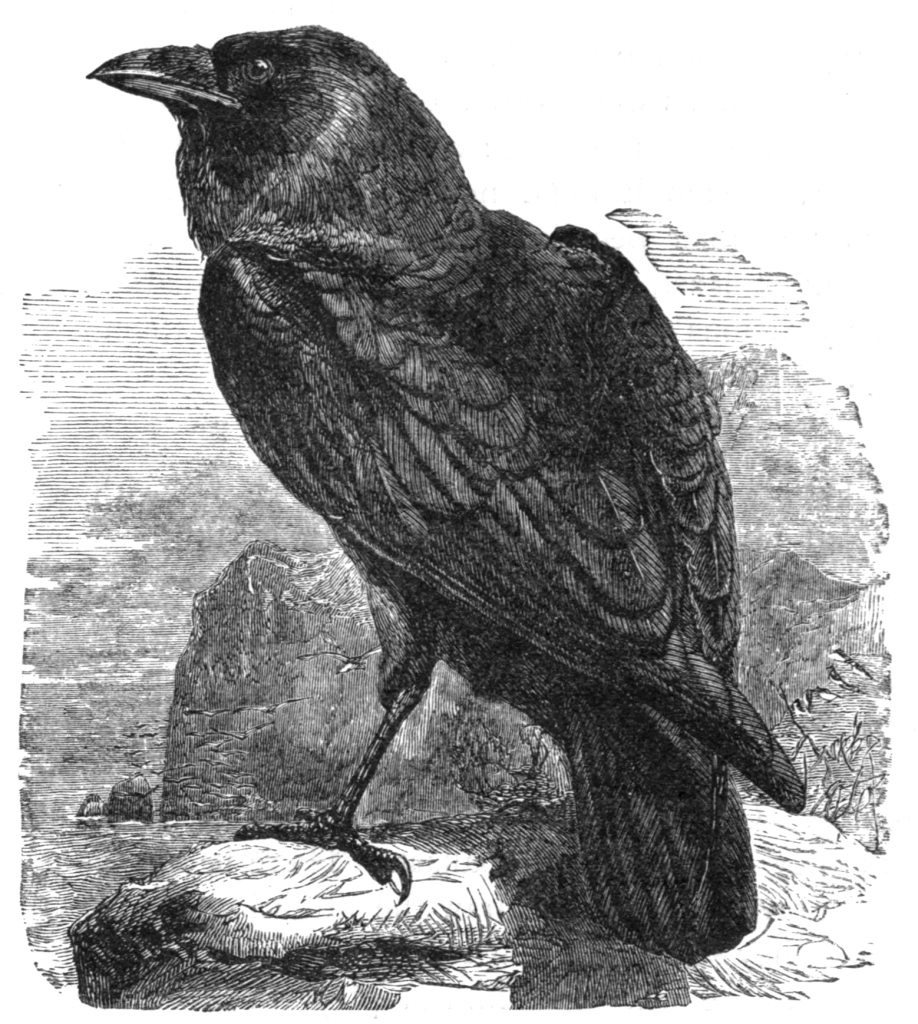
Image. “https://commons.wikimedia.org/w/index.php?curid=88895315” licensed under (CC BY-SA 4.0). More on Gilbert White https://www.nhm.ac.uk/discover/gilbert-white.html
Interview with Haida Master Sculpture Bill Reid.
The Indigenous First People of Australia passed down the legend of the Kookaburra bird with its loud and distinctive human-like laughter. Mythic legend has it that the god Bavame insisted that the Kookaburra wake humans up in early in the morning so as not to miss the beautiful sunrise. The Indigenous Australians referred to “Alcheringa” as “Dreamtime”. This period was conceptualized as a Golden Age was a time when the humans and animals were created. Spirit ancestors and mythic beings roamed the land by turning themselves into animals or rock formations. Lakes, waterholes, caves, and other rock formations were sacred sites to the Indigenous Australians. The “Dreamtime” or “Dreaming” is thought to be an ongoing journey that never ends.
The Raven
The Laughing Kookaburra
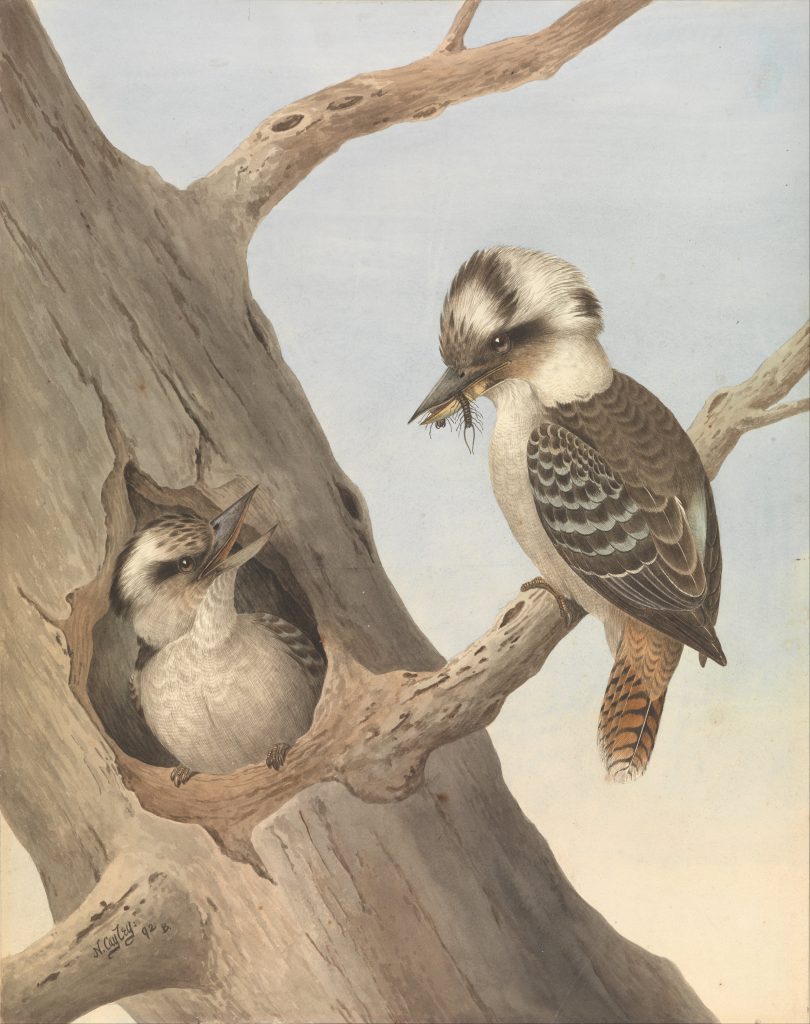
The Kookaburra by Louise Esson (1878-1943): Verses, Melbourne: Thomas C. Lothian, 1910, Birds and Bees.
Before the Age of Joy,
Before the Sphinx or the Pyramids,
Before the Siege of Troy,
And before the Alcheringa sighed,
In Australia desolate
The kookaburra, agog, descried
The tangled threads of Fate.
Scornful he glowered at the strange first dawn,
At the strange first stars he scoffed;
And he laughed, when the Veil of Life was drawn
On his bough i’ th’ blue aloft.
At Man and Evil and Destiny
Loud pealed his mocking laughter,
Because high perched on his gaunt gum-tree
He peered before and after.
Tho’ world on wonder world is shuffled
Thro’ fingers of Fate forever,
Unmoved he squats, this wise unruffled
Droll bird of the Never Never.
And moons and moons slip between each rime,
But perched on the same gum-tree,
He is waiting to laugh at the death of Time,
To mock Eternity.
Bird Species: Meaning and Association
| Cranes | Peace, blessings, good luck |
| Eagles | Courage, rebirth, power |
| Owl | Insight, wisdom, death |
| Swan | Light, twin flame, purity |
| Sparrow | Productivity, diligence, creativity |
| Peacock | Serenity, spring, vanity |
| Nightingale | Anticipation, Love, Secrets |
| Hummingbird | Joy, Love Healing |
| Falcons | Longevity, Victory, Nobility |
| Cardinal | Equilibrium, mystery |
| Bluebird | Joy, honesty, harmony |

